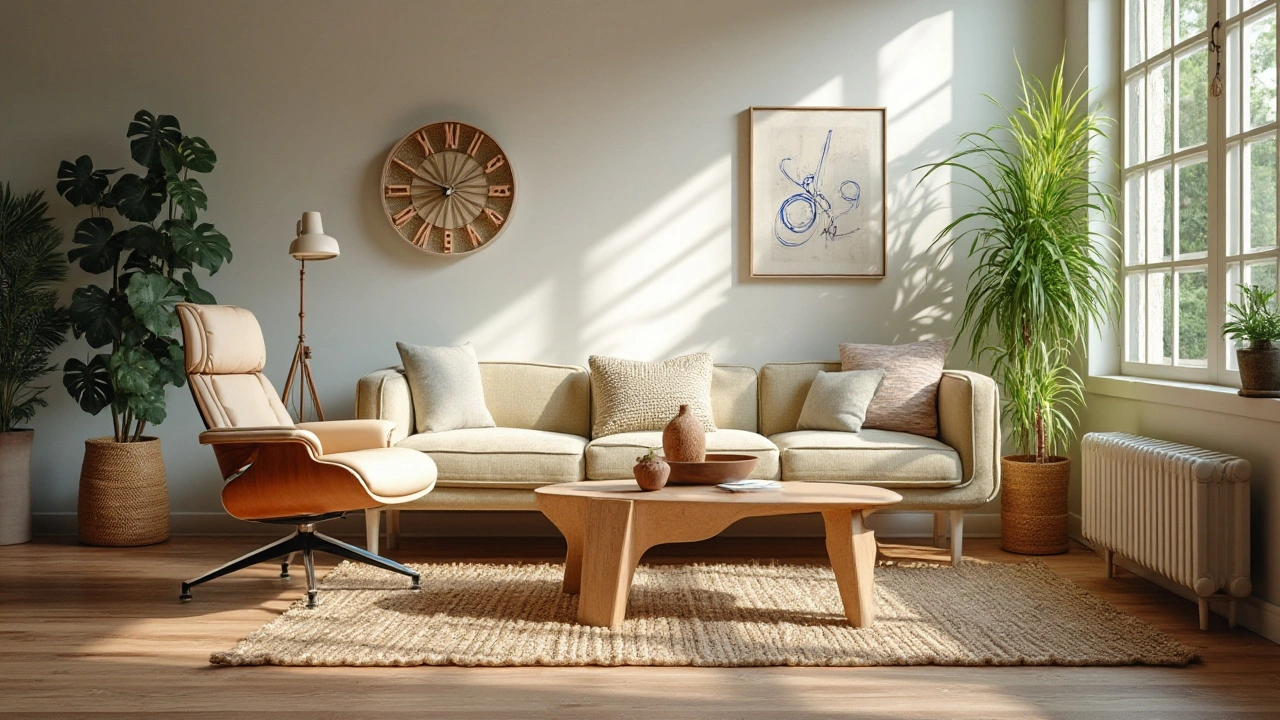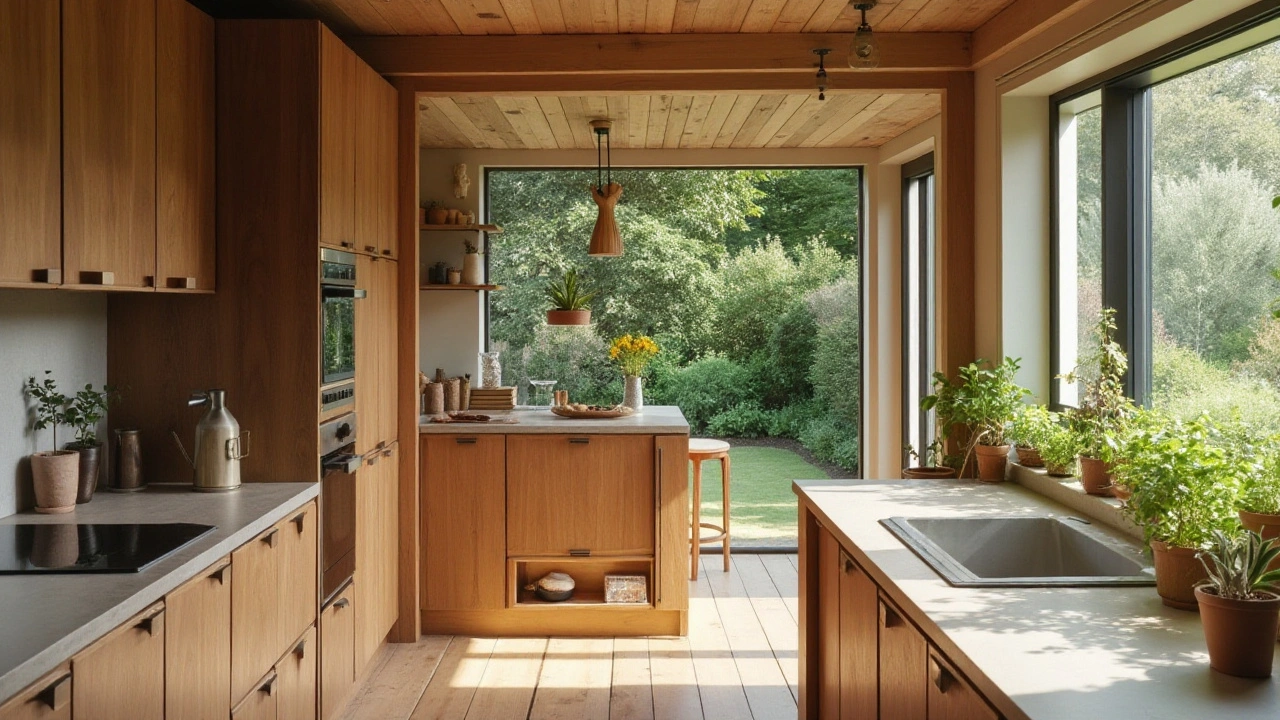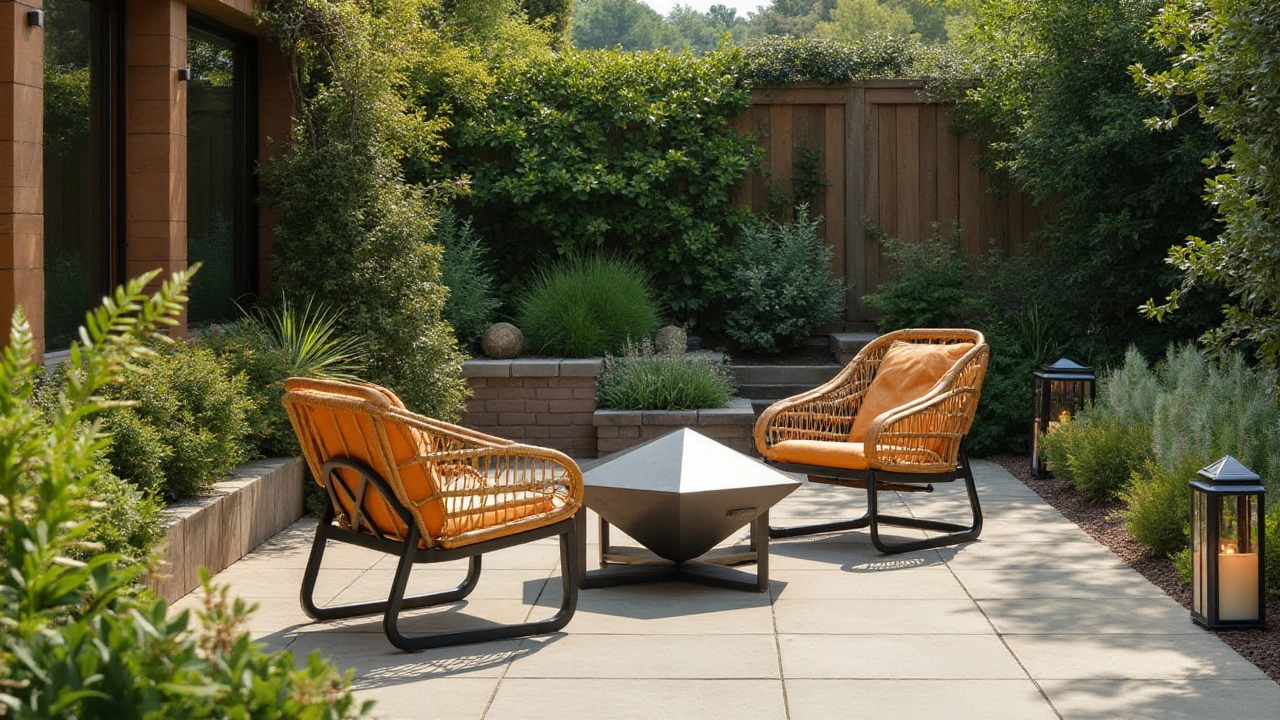Mid-Century Modern's Impact on Sustainable Home Design
 Oct, 26 2024
Oct, 26 2024
Mid-century modern design, with its clean lines and organic curves, remains a beloved style in homes around the world. But beyond its aesthetic appeal lies a fundamental compatibility with sustainable design principles. At its core, this design philosophy has always championed simplicity, functionality, and the integration of nature—elements that are essential to creating environmentally friendly living spaces.
The use of natural materials like wood and stone in mid-century modern décor not only brings warmth and texture into your home but also ensures longevity. This commitment to durability reduces the need for constant replacements, thus marrying style with sustainability. Moreover, the emphasis on minimalism minimizes waste, encouraging homeowners to make thoughtful choices about what they bring into their environments.
- Understanding Mid-Century Modern Design
- Sustainability in Design Principles
- Material Selection for Sustainable Décor
- The Role of Functionality and Durability
- Incorporating Mid-Century Modern Style Sustainably
Understanding Mid-Century Modern Design
Mid-century modern design is a style emanating from the mid-20th century, specifically around the 1940s to the late 1960s. It embodies clean lines, geometric forms, and a fusion of organic and synthetic materials. Iconic figures such as Charles and Ray Eames, Eero Saarinen, and George Nelson played pivotal roles in defining this design movement. They sought to break free from overly ornate styles that preceded them, instead opting for simplicity and functionality. This design ethos combined with advances in new materials technology during the era laid the groundwork for what we appreciate as mid-century modern today.
This design style finds its roots in the modernist movement, with an emphasis on minimalism. It values open spaces and an uncluttered look, encouraging an organic flow between indoor and outdoor spaces by integrating large windows and open layouts. This principle was somewhat revolutionary, aiming to bring the outside in, thus harmonizing the living environment with nature. The use of natural elements such as wood, stone, and clean-lined furniture helps create spaces that are not only stylish but also timeless, resonating with a sense of calm and relaxation.
One salient feature of the mid-century modern movement is its adaptability to new technologies and materials. Designers explored the use of plastic, fiberglass, and plywood—materials that were innovative at the time. Famous examples include the Eames Molded Plastic Chair and the Noguchi Coffee Table, each crafted to highlight the utility and aesthetic of these new resources without sacrificing durability. This forward-thinking approach is why many of these pieces have remained in demand, transcending fleeting fashion trends.
The appeal of mid-century modern decor lies in its ability to blend form and function seamlessly. Rooms designed in this style tend to emphasize open-plan layouts, maximizing natural light and air circulation. This openness fosters a sense of community within the home, linking living spaces in a way that fosters social interaction. This focus on functional design also manifests in the furniture of the period, with pieces that were crafted for comfort and utility. Iconic designs such as the Eames Lounge Chair not only look stunning but are also ergonomically sound, underscoring the practical side of this aesthetic.
A fascinating aspect is how mid-century modern design has continually influenced contemporary styles. As our society shifts towards more sustainable living practices, the principles of mid-century design—durability, simplicity, and integration with nature—prove their relevance. By choosing quality pieces that are both functional and beautiful, individuals can create homes that are not just visually appealing, but also enduringly sustainable, reducing the environmental impact of frequent furniture replacements.
Design critic Esther McCoy once remarked, “The members of the generation that came of age in the Fifties learned to recognize the beauty in simplicity.” This acknowledgment of simplicity as beauty is core to understanding why mid-century modern design continues to captivate and inspire.
Sustainability in Design Principles
Sustainability in design is not just a trend; it is an essential approach that resonates deeply with the philosophy of mid-century modern design. This style, which originated in the mid-20th century, has always embraced simplicity and functionality, making it perfectly suited to today's eco-friendly movements. By focusing on designs that use minimal materials without sacrificing style or durability, mid-century modern design encourages responsible resource usage. This alignment with sustainable practices is one of the reasons why it continues to be popular among environmentally-conscious homeowners.
To truly understand how mid-century modern principles promote sustainability, it's important to look at the materials they favor. Often crafted from locally-sourced, renewable resources such as wood, metal, and glass, these materials not only reduce carbon footprints but also add a unique charm to each piece of furniture or decor item. Quality and craftsmanship take precedence, making every piece long-lasting. This longevity is a key element of sustainability — reducing waste by ensuring that items do not need frequent replacement.
A significant feature of mid-century modern design is its focus on multi-functionality. Alongside being attractive, furniture often serves multiple purposes, like a coffee table with built-in storage. This reduces the need for excess furnishings, encouraging minimalism, which is a cornerstone of sustainable living. By doing more with less, homeowners can create spaces that are both beautiful and environmentally responsible.
Designers of the mid-century era were trailblazers in creating open layouts that integrate indoor and outdoor living spaces. Large windows, sliding doors, and open patios are common features, allowing for natural light and air to flow freely within the home. This not only reduces energy consumption for lighting and temperature control but also fosters a stronger connection with nature, which is at the heart of sustainable living.
Lloyd Alter, a design expert, once noted, "Sustainability isn't just about the materials but also about how you use them. The mid-century modern approach provides a blueprint for design that meets our current needs without compromising future generations."
Moreover, this design ethos supports repurposing and upcycling, which breathe new life into vintage pieces. Instead of discarding older items, mid-century modern design celebrates the past by incorporating classic pieces into contemporary spaces. Re-using vintage furniture not only honors the craftsmanship of previous eras but reduces the environmental impact of producing new materials.
Mid-century modern design's simplicity, functionality, and timeless appeal make it an ever-relevant model for sustainable design. By integrating nature, using durable materials, and promoting minimalism, it supports a balanced lifestyle that respects and protects our environment. This celebration of authenticity and efficiency ensures that our homes can be as nurturing to the planet as they are to us.

Material Selection for Sustainable Décor
When it comes to crafting a home that is both beautiful and eco-friendly, the choice of materials plays a crucial role. Mid-century modern design brings a lasting legacy of using materials that are not only stylish but also sustainable. Embracing the sustainable design approach begins with selecting interiors that honor longevity and environmental impact. This style traditionally incorporates natural resources like wood, stone, and leather, which are not only timeless but also reduce our ecological footprint. Wood, often a staple in mid-century modern pieces, comes in various sustainable options such as bamboo or reclaimed wood, providing both quality and conscience.
Mid-century modern designers were pioneers in the use of innovative materials. They embraced plastics and metals but did so in a manner that respected the natural world. Today, we can take inspiration from their bold experimentation and adapt it to fit eco-friendlier choices. For instance, recycled metals and sustainable plastics derived from renewable resources are alternatives that marry the sleek aesthetic of this design era with modern sustainability needs. Embracing these materials can help mitigate the environmental challenges posed by traditional production processes.
Another sustainable consideration within this style is the use of textiles. Mid-century modern décor often highlights upholstery made from natural fibers such as wool, cotton, and linen. By choosing organic or sustainably sourced fibers, one not only supports environmentally friendly farming but also ensures minimal pollution during the manufacturing process. These textiles lend texture and warmth to home interiors, translating the mid-century modern love for organic design into a tactile experience. Incorporating such materials can significantly lower a home's carbon footprint while accentuating its vintage charm.
Home decor enthusiasts should also consider the lifecycle of each material used within their space. A key tenet of sustainable design is promoting the longevity of furnishings and minimizing waste. Choosing durable materials translates into an extended lifespan for furniture and decor, reducing the need for replacements. In turn, this decreases the number of materials that end up in landfills. Antique or vintage pieces, central to mid-century modern interiors, offer a sustainable option by reusing and recycling furniture already in existence. This approach not only preserves history but also curbs consumption and waste creation.
The application of finishes and treatments to materials must not be overlooked. Eco-friendly finishes, such as water-based varnishes or zero-VOC paints, further enhance the sustainability quotient of home interiors. Carefully selecting products that prioritize the health of occupants while maintaining the aesthetic appeal of the mid-century modern style proves that one doesn’t have to compromise on design for the sake of sustainability. In fact, the removal of toxic substances epitomizes the balance of beauty and health.
"Sustainable design is not about the world of design. It's about the design of the world," said a renowned architect. This sentiment echoes the relationship between our material choices and the broader environmental impact.Each decision in material selection contributes to crafting a home space that is not only reflective of mid-century modern elegance but also a conscious commitment to sustainable living. As we find ourselves in an era where awareness and action are critical, adopting these mindful practices ensures our homes are as kind to the planet as they are pleasing to the eye.
The Role of Functionality and Durability
When it comes to mid-century modern design, its seamless blend of functionality and durability sets it apart as a beacon of sustainable design. The architects and designers of this era were visionary in their commitment to creating pieces that were not only aesthetically pleasing but built to last for generations. This focus on durability naturally aligns with the goals of sustainable living, leading to a reduction in waste and an emphasis on quality over quantity. Pieces from this era often feature meticulously crafted woodwork, a testament to the craftsmanship that ensures their longevity. Solid woods like teak and walnut were favored, not just for their rich tones, but for their ability to withstand the test of time, making them ideal for creating lasting furnishings.
One cannot overlook the importance of functionality in sustainable home design, and mid-century modern style excells at this. Designers like Charles and Ray Eames recognized that furniture should be as comfortable as it is stylish. Their iconic Eames Lounge Chair is a perfect example, blending high-end materials with ergonomic design principles. This emphasis on function means pieces are made to fit the way we live—offering both purpose and comfort, which leads to less need for constant replacement or upgrades. The efficient use of space and multi-functional designs, such as the famous credenza doubling as storage and a display unit, make these pieces versatile additions to any home.
In today's shift towards eco-friendly living spaces, it's intriguing to note how mid-century principles are more relevant than ever. They foster a sense of intentional living, where each item holds a purpose and brings a sense of joy. A thoughtful homeowner might choose a vintage piece for its history and craftsmanship or opt for a modern replica made with sustainable materials. Regardless, the core tenet remains: choosing pieces that will serve their function over the long haul. As we are reminded in the words of legendary designer Florence Knoll, "Good design is not a decoration, but a foundation for living." This philosophy of designing for the long haul ensures sustainability is at the heart of design.

Incorporating Mid-Century Modern Style Sustainably
When looking to bring the iconic vibe of mid-century modern style into your home, it’s possible to do so with a conscious commitment to the environment. This classic design is not only about aesthetics but also a thoughtful use of space and materials. To start, consider investing in timeless pieces that will last. Vintage furniture shopping becomes a treasure hunt where you can find gems that have aged gracefully, reducing the demand for new production that often strains natural resources. Pieces from this era, such as Eames chairs or Noguchi tables, were built with both form and function in mind and were meant to endure the test of time.
Emphasizing materials like wood, metal, and glass can also enhance both the style and sustainability of your decor. These materials can be sustainably sourced, ensuring that your efforts to decorate don’t come at a cost to the planet. Look for items made from salvaged wood or recycled metals, which carry a unique story and often show craftsmanship that adds character to a space. Bringing in natural textiles such as linen and cotton also supports both the mid-century aesthetic and the environmental cause. These fabrics are not only durable but also biodegradable, providing a gentle footprint on the earth.
Lighting plays a crucial role in mid-century modern design, with a focus on both function and form. The good news is energy-efficient options are plentiful today. Opt for LED bulbs, which use a fraction of the energy compared to traditional incandescent lighting and last significantly longer, aligning perfectly with the sustainable design ethos. Additionally, incorporating large windows not only harnesses natural light but also creates a bridge to the outdoors, a hallmark of mid-century architecture that promotes a strong connection with nature.
Eco-friendly paints and finishes allow you to maintain or restore the glorious hues of mid-century palette—think warm earthy tones and vibrant accents—without introducing harmful chemicals into your living space. Many brands now offer non-toxic options that provide both safety and style. Implementing these choices requires some consideration upfront but pays dividends in the warmth and well-being they bring into your environment.
Thoughtful curation is key when transforming a living space into a sanctuary that is both stylish and sustainably conscious. Embrace minimalism, selecting quality over quantity, and find joy in fewer, meaningful possessions. As the renowned designer Charles Eames once said, "The details are not the details. They make the design." His philosophy encourages us to savor the intricate beauty derived from each piece—and how it sustains both its user and the world around us.
As you explore adding mid-century modern elements to your décor, remember that sustainability involves a commitment to practices that support the Earth’s longevity while promoting comfort and joy in our homes. Each element, from recycled materials to energy-efficient lighting, offers an opportunity to live in harmony with the environment, making this classic style more relevant and essential than ever.